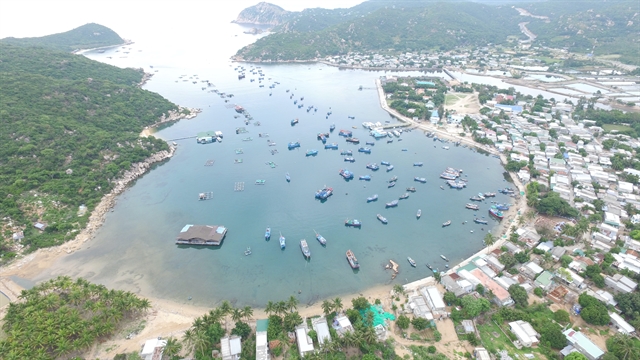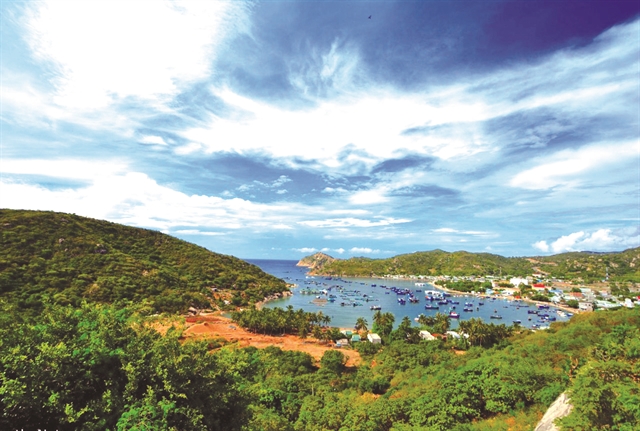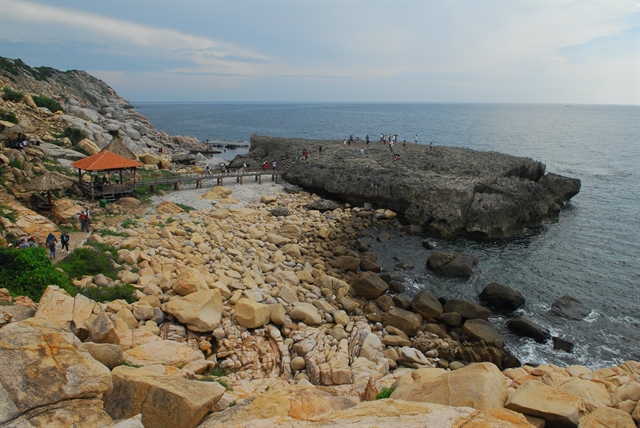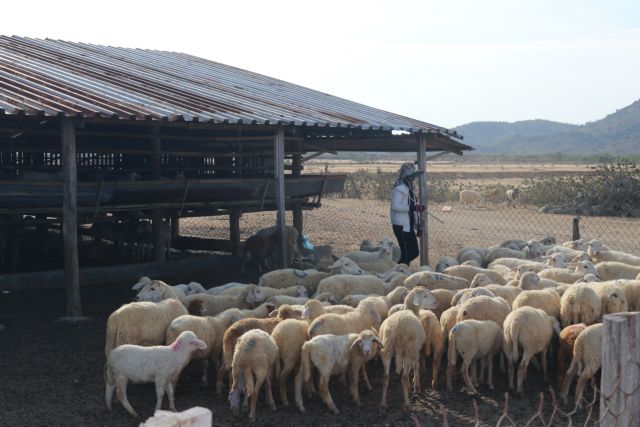 Features
Features

Sunny, windy Ninh Thuận has come into reckoning as a renewable energy hub, but the surprisingly diverse province has much more to offer. Bồ Xuân Hiệp explains.

|
| Adjacent to Ninh Chữ beach and Núi Chúa National Park, the Vĩnh Hy Bay is one of the world’s nine recognised biospheres. VNA/VNS Photo Mạnh Linh |
Sunny, windy Ninh Thuận has come into reckoning as a renewable energy hub, but the surprisingly diverse province has much more to offer. Bồ Xuân Hiệp explains.
As an inveterate hodophile, there is nothing I’d rather do than see as much of the world as I can.
When the Covid-19 outbreak locked down places and I was infected with the virus, the travel itch had to take a backseat.
The process of turning inward during this period of isolation took an unexpected turn for me when Việt Nam began to better control the pandemic and made a timely switch to “living with the virus”, making travel a possibility again.
Instead of waiting for outbound flights to new destinations, I looked for a place within the country that does not commonly figure in holiday plans for Vietnamese and foreigners who typically head to beaches or mountainous resorts.
And that is how I chanced upon Ninh Thuận, a province that had made big news both as the site of the nation’s first nuclear power plant and as one that “lost out” on a major development opportunity when this plan was shelved.
It is poetic justice, of course, that the province has now become the go-to place in the country for developing solar and wind energy, but it is only when I looked at the province with a traveller’s eye that its many attractions came into sharper focus – its cultural diversity, the historic monuments that it hosts, the diversity and beauty of its topographical landscapes, and the unique culinary twist it gives to dishes that are popular all over the country.
I also discovered that the long coastline with which it is endowed not only allows the province the opportunity to promote beach tourism, but also forms other resources to develop its marine economy.
The icing on the cake, for now, is that its non-mainstream status makes it an unspoilt destination without touristy add-ons that can take the sheen off a place’s special charms.
So don’t expect to see many bars, massage parlours and such facilities that have mushroomed in the popular hotspots.
And therefore, I would highly recommend you visit Ninh Thuận now, as soon as you can, and enjoy its pristine nature.
Towering monument to peace
Where there are spectacular historic and cultural vestiges, the usual stories and legends that are attached to them have to do with courage, mostly on battlefields.
However, the Po Klong Garai tower complex in Phan Rang City steers a completely different path. It is said when the invaders from the south attacked the then Champa Kingdom's municipality of Panduranga, in what is now Phan Rang, King Po Klong Garai suggested the issue be settled peacefully with a tower building contest. He won and the invaders withdrew.
The tower complex was built in the 13th-14th centuries with crimson red terracotta bricks joined together with resin from dầu rái, a local tree (Dipterocarpus alatus), it is said.
Apart from such fascinating legends, encountering the customs and traditions that are still prevalent among the Chăm ethnic minority is another enjoyable experience that Ninh Thuận has to offer.
Artisanal pottery and handloom fabrics, buffalo-driven carts, rice mills, traditional musical instruments, and costumes worn by Chăm monks also tell us stories.
Another “surprise” for me is that while Ninh Thuận is famous for having a lot of sunshine and wind, and being arid all year round, it is also a place that hosts many vineyards.
Walking through the Ba Mọi vineyard, eight kilometres from Phan Rang City, enjoying some freshly picked grapes and tasting some wine can be an interesting experience.
Yet another surprise in store for me was sheep and meadows. Yes, sheep and meadows, and no, this is nothing like Heidi’s Switzerland.
The An Hòa sheep farm has many herds, from a few hundred to even several thousand, that free graze on a large steppe meadow.
The charming countryside also hosts cows, goats and chickens that wander about jauntily.
Food for thought and more
To satisfy a basic or a more serious curiosity about the province’s history and culture, a visit to the Ninh Thuận Museum located in the city centre is highly recommended.
It currently displays more than 40,000 artefacts, documents, images, offering interesting insights into the historical and cultural characteristics of various ethnic minorities in the province, like the Chăm, Raglai and Chu Ru.
All this wandering about makes one hungry, of course, and therein lies further surprising twists.
I can happily reveal that my favourite dish here is bún mắm nêm (rice vermicelli served with mắm nêm), some slices of boiled pork, boiled pig’s ears and beef bologna.
Mắm nêm is a type of Vietnamese fermented anchovy sauce, with an acquired smell and taste that’s much more pungent than typical fish sauce. When served in dishes, the sauce is mixed with other ingredients like pineapple, lime juice, garlic, sugar and fresh chili.
Other dishes worth trying in the province are Phan Rang chicken rice, bánh canh chả cá (rice noodles with fish nuggets), bánh xèo (sizzling crepe), grilled lamb and, of course, lots of seafood.
‘Island of life’
It’s not an island, actually. The Núi Chúa National Park is called an “island of life” or even an “oasis” because it is a preserved natural space protecting the country’s marine flora and fauna. Spread over an area of more than 30,000ha, the park’s biodiversity is something to marvel at.
It is home to 70 mammal and 180 bird species so wildlife enthusiasts will have a particularly great time here. Some of Việt Nam and probably Asia’s rarest animals, including the pygmy loris, sun bear, Asian black bear, large-antlered muntjac, and black-shanked douc call the park their home.
As many as 12 bat species hide in the park’s cave, one of which, the lesser short-nosed fruit bat, is listed in Việt Nam’s Red List of endangered species.
The oceanic ecosystem of the park is home to an array of aquatic plants and animals, including 11 turtle species.
Sea turtles frequent some of the beaches to lay their eggs, while others remain terrestrial and hidden in the mountainous terrain.
The park is also a good place to hike, go boating and enjoy leisurely swimming; and those with more time to spend can go to the buffer zone and book a homestay.
The rock formations and fossilised coral reefs of Hang Rái Vĩnh Hy (Rái Cave at Vĩnh Hy Bay) are an out of the world sight that lend themselves easily to spectacular photographs.
Marine economy
I met up with Nguyễn Văn Hoà, director of the province’s Department of Culture, Sports and Tourism, and he spoke to me about the province’s focus on developing its marine economy.
With a 105-km coastline, scenic landscapes, abundant aquatic resources and marine biodiversity, Ninh Thuận has great potential to develop a sea-based economy, according to the director.
“The maritime economy, in which tourism plays a key role, is set to grow by 15 per cent annually until 2025,” he added.
Ninh Thuận has set a target this year to welcome 1.9 million visitors, including 15,000 international visitors, earning tourism revenues of VNĐ1.4 trillion.
The corresponding figures for 2025 are 3.5 million visitors including 455,000 foreigners, and VNĐ2.9 trillion ($127.1 million) in tourism revenue. These will rise to 6 million, 900,000, and VNĐ5.9 trillion in 2030, respectively, the province expects.
Trần Quốc Nam, chairman of the Ninh Thuận People’s Committee, said that to achieve its growth goals, the province would focus on marine tourism development and diversification of tourism products such as eco-tourism and community-based tourism.
It planned to develop domestic tourism further and to recover some of its international markets like Eastern Europe, he added.
Efforts would be also made to attract high-end tourists from the existing markets and approach new ones in Southeast Asia, Western Europe and North America.
The province has created a tourism portal with information updated regularly. Visitors only need to install the app to discover tourism sites, accommodations and restaurants.
The province has come up with investment mechanisms and policies to attract funding for major tourist and resort projects to form high-class tourist areas with the best service quality.
Recently, the F.I.T and Crystal Bay groups began construction of the $1-billion Cap Padaran Mũi Dinh project in Thuận Nam District.
Covering 800ha, the international-standard facility will feature luxury hotels, resorts, beach villas and entertainment and sports complexes.
Then there is the 64ha Bãi Tràng (Tràng Beach) resort whose first phase is being built at a cost of $150 million.
Besides all this, Ninh Thuận has one of the country’s most luxurious resorts to date in the Núi Chúa National Park beside Vĩnh Hy Bay, which is recognised as one of the world’s nine biospheres. Amanoi is the first six-star resort in the country.
The province has announced a list of 67 key projects calling for investment. These will develop residential areas, urban areas, tourism and high-tech industries, as well as support industries serving renewable energy, mechanical engineering, seafood processing, salt production, and shipbuilding and repair.
The province is speeding up the progress of key projects, including a seaport complex, an inland port, a logistics services centre, as well as routes linking seaports with expressways.
As of last year, Ninh Thuận granted investment certificates for 47 marine industrial projects with a total registered capital of more than VNĐ2 trillion ($87.66 million), and 25 of these are already operational.
Sustainable fisheries
Ninh Thuận is one of the four largest fisheries producers in the country.
According to Đặng Văn Tín, head of Ninh Thuận’s Fisheries Sub-department, the province targets having an aquaculture output of 119,500 tonnes this year, of which offshore fishing accounts for 70 per cent of the total output.
It also targets having 500-600ha of aquaculture farms on shore and 1,000ha offshore with an annual output of 110,000-150,000 tonnes by 2025, producing tuna, cobia, grouper, pomfret, oysters, and lobsters.
It is also among the country’s largest shrimp broodstock producers, with its annual volume of baby shrimp output increasing to 24.9 billion in 2017 from 6.1 billion in 2007. It has a target of 41 billion fry by 2025.
Experts have called on the province to learn the lessons from already established tourist hotspots to ensure biodiversity conservation and marine environment protection while promoting the value of the heritages.
Now’s the time
To get to Ninh Thuận, the majority of international visitors would have to travel from HCM City to Phan Rang City, which is some 320km away.
Driving to Ninh Thuận from HCM City takes around six hours and taking a train is a little faster. I would recommend the latter for the stunning views.
The Tháp Chàm Railway Station is on the main North-South railway, which takes about five hours to get to from HCM City’s Sài Gòn Station.
Alternatively, the nearest airport to Phan Rang is some 60km away, at Cam Ranh International Airport in Khánh Hòa Province.
A 45-minute flight from Tân Sơn Nhất Airport in HCM City to Cam Ranh Airport would, however, require an additional one hour and a half drive from the airport to Phan Rang.
To conclude, I personally think it will be a challenging task to maintain the characteristics of an unspoilt area while going on a building spree as Ninh Thuận is doing. It is already evident that the number of resorts and tourism facilities that have begun operating along the coast is increasing.
So I have to reiterate that there is no better time to visit Ninh Thuận than now. Now!. VNS

|
| The 10-km long white sandy Ninh Chữ Beach, one of the most serene beaches in the central region, has been gaining popularity for its calm, turquoise waters. VNA/VNS Photo Mạnh Linh |

|
| Situated at a height of 1,000 metres above sea level, the Núi Chúa National Park overlooking Vĩnh Hy Bay is the only preserved natural space protecting the country’s marine flora and fauna. Photo keepthenature.com |

|
| Built in the 13th-14th century, the Po Klong Garai Tower complex in Phan Rang City opens a window into architectural brilliance of the Cham Kingdom. VNA/VNS Photo Mạnh Linh |

|
| The Hang Rái Vĩnh Hy (Rái Cave at Vĩnh Hy Bay) is an out of the world sight that lends itself easily to spectacular photographs. VNA/VNS Photo Mạnh Linh |

|
| The An Hoà farm has many herds of sheep that free graze on a large steppe meadow. VNA/VNS Photo Mạnh Linh |




